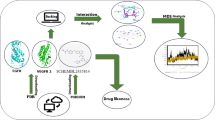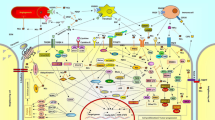Abstract
Previously , we demonstrated that the non-antibiotic penicillin derivative TAP7f inhibited melanoma metastasis in vitro and in vivo through the downregulation of β-catenin and integrin αVβ3. As angiogenesis is required for tumor growth and metastasis, we decided to explore the possible antiangiogenic effect of TAP7f. We found that TAP7f inhibited proliferation, migration, tube formation, and actin cytoskeleton organization of human endothelial cells. In a gel plug assay, an in vivo model for angiogenesis, TAP7f also blocked vascular formation induced by fibroblast growth factor 2. Furthermore, when murine B16-F10 melanoma cells pre-treated with TAP7f were injected intradermally in mice, we observed a decrease in the number and thickness of the capillaries surrounding the tumor. Additionally, TAP7f downregulated vascular endothelial growth factor (VEGF) and platelet-derived growth factor-B (PDGF-B) expression in B16-F10 cells and VEGF receptor expression in HMEC-1 endothelial cells. When the antitumor effect of TAP7f was studied in C57BL/6 J mice challenged with B16-F10 melanoma cells, a significant reduction of tumor growth was observed. Furthermore, a decreased expression of VEGF, PDGF-B, and the endothelial cell marker CD34 was observed in tumors from TAP7f-treated mice. Together, our results suggest that the antiangiogenic activity of TAP7f contributes to its antitumor and antimetastatic action and positions this penicillin derivative as an alternative or complementary agent for the treatment of melanoma.
Key messages
• TAP7f inhibits proliferation, migration, tube formation, and actin cytoskeleton organization of endothelial cells.
• TAP7f downregulates VEGF receptor expression in endothelial cells.
• TAP7f downregulates VEGF and PDGF expression in melanoma cells.
• TAP7f inhibits angiogenesis in vivo.








Similar content being viewed by others
Data availability
All data supporting the findings of this study are available from the corresponding author upon reasonable request.
References
Folkman J (1995) Angiogenesis in cancer, vascular, rheumatoid and other disease. Nat Med 1:27–31. https://doi.org/10.1038/nm0195-27
Potente M, Gerhardt H, Carmeliet P (2011) Basic and therapeutic aspects of angiogenesis. Cell 146:873–887. https://doi.org/10.1016/j.cell.2011.08.039
Carmeliet P, Jain RK (2000) Angiogenesis in cancer and other diseases. Nature 407:249–257. https://doi.org/10.1038/35025220
Folkman J (2006) Angiogenesis. Annu Rev Med 57:1–18. https://doi.org/10.1146/annurev.med.57.121304.131306
Li T, Kang G, Wang T, Huang H (2018) Tumor angiogenesis and anti-angiogenic gene therapy for cancer. Oncol Lett 16:687–702. https://doi.org/10.3892/ol.2018.8733
Lamalice L, Le Boeuf F, Huot J (2007) Endothelial cell migration during angiogenesis. Circ Res 100:782–794. https://doi.org/10.1161/01.RES.0000259593.07661.1e
Kerbel RS (2008) Tumor angiogenesis. N Engl J Med 358:2039–2049. https://doi.org/10.1056/NEJMra0706596
Cao Y, Cao R, Hedlund E-M (2008) R Regulation of tumor angiogenesis and metastasis by FGF and PDGF signaling pathways. J Mol Med 86:785–789. https://doi.org/10.1007/s00109-008-0337-z
Cho WC, Jour G, Aung PP (2019) Role of angiogenesis in melanoma progression: update on key angiogenic mechanisms and other associated components. Semin Cancer Biol 59:175–186. https://doi.org/10.1016/j.semcancer.2019.06.015
Mahabeleshwar GH, Byzova TV (2007) Angiogenesis in melanoma. Semin Oncol 34:555–565. https://doi.org/10.1053/j.seminoncol.2007.09.009
Dewing D, Emmett M, Pritchard Jones R (2012) The roles of angiogenesis in malignant melanoma: trends in basic science research over the last 100 years. ISRN Oncol 2012:1–7. https://doi.org/10.5402/2012/546927
Luu HH, Zhang R, Haydon RC et al (2004) Wnt/beta-catenin signaling pathway as a novel cancer drug target. Curr Cancer Drug Targets 4:653–671. https://doi.org/10.2174/1568009043332709
Hodorogea A, Calinescu A, Antohe M et al (2019) Epithelial-mesenchymal transition in skin cancers: a review. Anal Cell Pathol 2019. https://doi.org/10.1155/2019/3851576
Poltavets V, Kochetkova M, Pitson SM, Samuel MS (2018) The role of the extracellular matrix and its molecular and cellular regulators in cancer cell plasticity. Front Oncol 8:1–19. https://doi.org/10.3389/fonc.2018.00431
Sottile J (2004) Regulation of angiogenesis by extracellular matrix. Biochim Biophys Acta - Rev Cancer 1654:13–22. https://doi.org/10.1016/j.bbcan.2003.07.002
Cornier PG, Delpiccolo CML, Mascali FC et al (2014) In vitro anticancer activity and SAR studies of triazolyl aminoacyl(peptidyl) penicillins. Medchemcomm 5. https://doi.org/10.1039/c3md00332a
Blank V, Bellizzi Y, Zotta E et al (2018) A novel penicillin derivative induces antitumor effect in melanoma cells. Anticancer Drugs 29. https://doi.org/10.1097/CAD.0000000000000611
Bellizzi Y, Anselmi Relats JM, Cornier PG et al (2022) Contribution of endoplasmic reticulum stress, MAPK and PI3K/Akt pathways to the apoptotic death induced by a penicillin derivative in melanoma cells. Apoptosis 27:34–48. https://doi.org/10.1007/s10495-021-01697-7
Bellizzi Y, Cornier PG, Delpiccolo CML et al (2022) Synergistic antitumor effect of a penicillin derivative combined with thapsigargin in melanoma cells. J Cancer Res Clin Oncol. https://doi.org/10.1007/s00432-022-04129-4
Barrionuevo E, Cayrol F, Cremaschi GA et al (2020) A penicillin derivative exerts an anti-metastatic activity in melanoma cells through the downregulation of integrin αvβ3 and Wnt/β-catenin pathway. Front Pharmacol 11. https://doi.org/10.3389/fphar.2020.00127
Landegren U (1984) Measurement of cell numbers by means of the endogenous enzyme hexosaminidase. Applications to detection of lymphokines and cell surface antigens. J Immunol Methods 67:379–388. https://doi.org/10.1016/0022-1759(84)90477-0
Bielenberg DR, Zetter BR (2015) The contribution of angiogenesis to the process of metastasis. Cancer J 21:267–273. https://doi.org/10.1097/PPO.0000000000000138
Prigozhina NL, Heisel A, Wei K et al (2011) Characterization of a novel angiogenic model based on stable, fluorescently labelled endothelial cell lines amenable to scale-up for high content screening. Biol Cell 103. https://doi.org/10.1111/j.1768-322x.2011.tb01308.x
Ades EW, Candal FJ, Swerlick RA et al (1992) HMEC-1: establishment of an immortalized human microvascular endothelial cell line. J Invest Dermatol 99:. https://doi.org/10.1111/1523-1747.ep12613748
Bouïs D, Hospers GAP, Meijer C et al (2001) Endothelium in vitro: a review of human vascular endothelial cell lines for blood vessel-related research. Angiogenesis 4
Bauer J, Margolis M, Schreiner C et al (1992) In vitro model of angiogenesis using a human endothelium-derived permanent cell line: contributions of induced gene expression, G-proteins, and integrins. J Cell Physiol 153:437–449. https://doi.org/10.1002/jcp.1041530302
Bayless KJ, Johnson GA (2011) Role of the cytoskeleton in formation and maintenance of angiogenic sprouts. J Vasc Res 48
Thoenes L, Günther M (2008) Novel approaches in anti-angiogenic treatment targeting endothelial F-actin: a new anti-angiogenic strategy? Curr Opin Mol Ther 10:579–590
Bhat S, Shim JS, Liu JO (2013) Tricyclic thiazoles are a new class of angiogenesis inhibitors. Bioorganic Med Chem Lett 23. https://doi.org/10.1016/j.bmcl.2013.02.067
Zhou W, Tang W, Sun Z et al (2016) Discovery and optimization of N-substituted 2-(4-pyridinyl)thiazole carboxamides against tumor growth through regulating angiogenesis signaling pathways. Sci Rep 6. https://doi.org/10.1038/srep33434
Prashanth T, Thirusangu P, Vijay Avin BR et al (2014) Synthesis and evaluation of novel benzophenone-thiazole derivatives as potent VEGF-A inhibitors. Eur J Med Chem 87. https://doi.org/10.1016/j.ejmech.2014.09.069
Zabala-Uncilla N, Miranda JI, Laso A et al (2017) Linear and cyclic depsipeptidomimetics with β-lactam cores: a class of new αvβ3 integrin receptor inhibitors. ChemBioChem 18:654–665. https://doi.org/10.1002/cbic.201600642
Nathwani S-M, Hughes L, Greene LM et al (2013) Novel cis-restricted β-lactam combretastatin A-4 analogues display anti-vascular and anti-metastatic properties in vitro. Oncol Rep 29:585–594. https://doi.org/10.3892/or.2012.2181
Ziyad S, Iruela-Arispe ML (2011) Molecular mechanisms of tumor angiogenesis. Genes Cancer 2:1085–1096. https://doi.org/10.1177/1947601911432334
Lutsenko S V., Kiselev SM, Severin SE (2003) Review: molecular mechanisms of tumor angiogenesis. Biokhimiya 68:
Lugano R, Ramachandran M, Dimberg A (2020) Tumor angiogenesis: causes, consequences, challenges and opportunities. Cell Mol Life Sci 77
Bates DO (2010) Vascular endothelial growth factors and vascular permeability. Cardiovasc Res 87:262–271. https://doi.org/10.1093/cvr/cvq105
Melincovici CS, Boşca AB, Şuşman S et al (2018) Vascular endothelial growth factor (VEGF) – key factor in normal and pathological angiogenesis. Rom J Morphol Embryol 59
Ferrara N, Hillan KJ, Gerber H-P, Novotny W (2004) Discovery and development of bevacizumab, an anti-VEGF antibody for treating cancer. Nat Rev Drug Discov 3:391–400. https://doi.org/10.1038/nrd1381
Furuhashi M, Sjöblom T, Abramsson A et al (2004) Platelet-derived growth factor production by B16 melanoma cells leads to increased pericyte abundance in tumors and an associated increase in tumor growth rate. Cancer Res 64:2725–2733. https://doi.org/10.1158/0008-5472.CAN-03-1489
Wang Y, Sang A, Zhu M et al (2016) Tissue factor induces VEGF expression via activation of the Wnt/β-catenin signaling pathway in ARPE-19 cells. Mol Vis 22:886–897
Fernández JG, Rodríguez DA, Valenzuela M et al (2014) Survivin expression promotes VEGF-induced tumor angiogenesis via PI3K/Akt enhanced β-catenin/Tcf-Lef dependent transcription. Mol Cancer 13:209. https://doi.org/10.1186/1476-4598-13-209
Qu B, Liu B-R, DU Y-J et al (2014) Wnt/β-catenin signaling pathway may regulate the expression of angiogenic growth factors in hepatocellular carcinoma. Oncol Lett 7:1175–1178. https://doi.org/10.3892/ol.2014.1828
Contois LW, Akalu A, Caron JM et al (2015) Inhibition of tumor-associated αvβ3 integrin regulates the angiogenic switch by enhancing expression of IGFBP-4 leading to reduced melanoma growth and angiogenesis in vivo. Angiogenesis 18:31–46. https://doi.org/10.1007/s10456-014-9445-2
Cayrol F, Sterle HA, Díaz Flaqué MC et al (2019) Non-genomic actions of thyroid hormones regulate the growth and angiogenesis of T cell lymphomas. Front Endocrinol (Lausanne) 10:63. https://doi.org/10.3389/fendo.2019.00063
Chapman PB, Hauschild A, Robert C et al (2011) Improved survival with vemurafenib in melanoma with BRAF V600E mutation. N Engl J Med 364:2507–2516. https://doi.org/10.1056/NEJMoa1103782
Hauschild A, Grob J-J, Demidov LV et al (2012) Dabrafenib in BRAF-mutated metastatic melanoma: a multicentre, open-label, phase 3 randomised controlled trial. Lancet (London, England) 380:358–365. https://doi.org/10.1016/S0140-6736(12)60868-X
Heppt MV, Siepmann T, Engel J et al (2017) Prognostic significance of BRAF and NRAS mutations in melanoma: a German study from routine care. BMC Cancer 17:536. https://doi.org/10.1186/s12885-017-3529-5
Chapman PB, Robert C, Larkin J et al (2017) Vemurafenib in patients with BRAFV600 mutation-positive metastatic melanoma: final overall survival results of the randomized BRIM-3 study. Ann Oncol Off J Eur Soc Med Oncol 28:2581–2587. https://doi.org/10.1093/annonc/mdx339
Carlino MS, Gowrishankar K, Saunders CAB et al (2013) Antiproliferative effects of continued mitogen-activated protein kinase pathway inhibition following acquired resistance to BRAF and/or MEK inhibition in melanoma. Mol Cancer Ther 12:1332–1342. https://doi.org/10.1158/1535-7163.MCT-13-0011
Sinnberg T, Makino E, Krueger MA et al (2016) A nexus consisting of beta-catenin and Stat3 attenuates BRAF inhibitor efficacy and mediates acquired resistance to vemurafenib. EBioMedicine 8:132–149. https://doi.org/10.1016/j.ebiom.2016.04.037
Li X, Xiang Y, Li F et al (2019) WNT/β-catenin signaling pathway regulating T cell-inflammation in the tumor microenvironment. Front Immunol 10. https://doi.org/10.3389/fimmu.2019.02293
Acknowledgements
We are thankful to Dr. Magali Cercato for her help with the histological processing of tissues and Marianela Vence for her help with in vivo assays.
Funding
This work was supported by grants from the Consejo Nacional de Investigaciones Científicas y Técnicas (CONICET, PIP 0154: “Propiedades y mecanismo de acción de nuevos agentes antitumorales: péptidos quiméricos del IFN alfa, ftalocianinas de Zn(II) y derivados sintéticos de penicilinas”; PUE-2016: “Contribución al proceso de desarrollo del medicamento. Anti-infecciosos y anti-cancerígenos”), Universidad de Buenos Aires (Programación Científica 2018–2020, UBACYT 20020170100041BA: “Mecanismos de acción in vitro e in vivo de novedosos agentes antitumorales. Implementación de estrategias terapéuticas innovadoras”), and Agencia Nacional de Promoción Científca y Tecnológica (ANPCyT, PICT 2017–1278: “Mecanismo de acción antitumoral de péptidos quiméricos del IFN-α2b y compuestos peptidomiméticos. Efecto del tratamiento combinado con hipertermia magnética”; PICT 2017–2694: “Diseño de nuevas metodologías para la generación de scaffolds cíclicos y heterocíclicos sintética y biológicamente atractivos. Los productos naturales como fuente de inspiración”), Argentina.
Author information
Authors and Affiliations
Contributions
EB, LPR, and VCB hypothesized, designed the research plan, and performed in vivo experiments. EB performed the required in vitro experiments. PGC, CMLD, and EGM synthesized and purified the TAP7f. EB, LPR, and VCB analyzed the data. VCB compiled the data and wrote the first draft of the manuscript. All authors revised and approved the final manuscript before submission.
Corresponding author
Ethics declarations
Ethics approval
The in vivo experiments were carried out in accordance with the principles of the Basel Declaration and recommendations of the National Institute of Health (NIH) Guide for the Care and the Use of Laboratory Animals and approved by the Institutional Animal Care and Use Committee (CICUAL) of the School of Pharmacy and Biochemistry, University of Buenos Aires (14–1-2019/ Res No. 217/19).
Competing interests
The authors declare no competing interests.
Additional information
Publisher's Note
Springer Nature remains neutral with regard to jurisdictional claims in published maps and institutional affiliations.
Rights and permissions
Springer Nature or its licensor (e.g. a society or other partner) holds exclusive rights to this article under a publishing agreement with the author(s) or other rightsholder(s); author self-archiving of the accepted manuscript version of this article is solely governed by the terms of such publishing agreement and applicable law.
About this article
Cite this article
Barrionuevo, E., Cornier, P.G., Delpiccolo, C.M.L. et al. Antiangiogenic activity of the penicillin derivative TAP7f in melanoma. J Mol Med 101, 249–263 (2023). https://doi.org/10.1007/s00109-023-02287-7
Received:
Revised:
Accepted:
Published:
Issue Date:
DOI: https://doi.org/10.1007/s00109-023-02287-7




